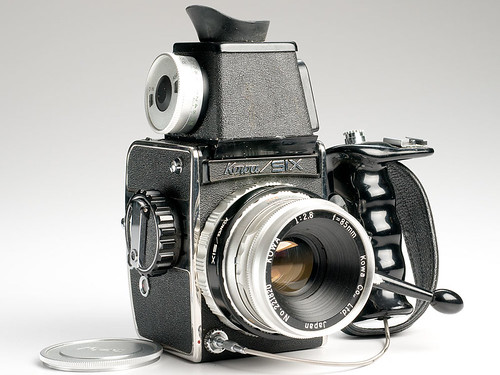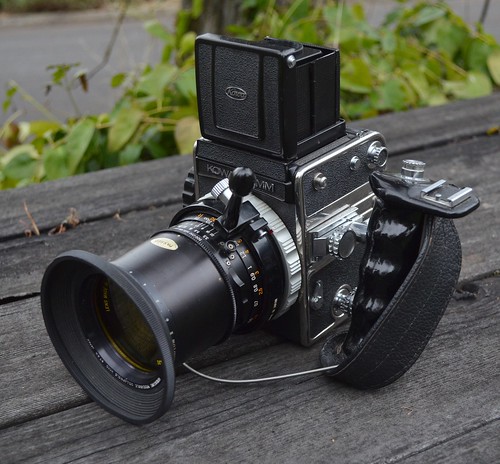Kowa Six
The Kowa Six is an SLR camera for 6x6 cm pictures on 120 film, made by Kowa in the 1960s. The Kowa Six MM is an improved model, allowing multiple-exposure and with a mirror lock.[1] This was followed by the Super 66, which has detachable film magazines.
These cameras were designed to compete the Hasselblad cameras. Unlike these famous models, film is not included in a magazine but in the body itself : the film follows à «L» course, like in the Great Wall DF cameras.
Despite the high quality of the Kowa lenses, the mirror movement may create vibrations which make the focusing ring to rotate itself, thus shifting the focus. The focus ring has to be held tightly when firing. Users are also recommended to turn the shutter and film knob carefully, in order to not to jam the camera. Opening the camera and taking out the film then restores the system.
The Kowa six is a well-built, heavyweight camera, 4 lbs./1.81kg with the pop-up finder, but pleasant to handle and to use.

|
| Kowa Six image by Peter M Lerman (Image rights) |

|
| Kowa Six MM image by Terry Skibby (Image rights) |
Contents
System
Lens
- 19mm f/4.5 Fisheye (14 elements in 9 groups)
- 35mm f/4 (10 elements in 6 groups) 95mm filter
- 40mm f/4 (9 elements in 7 groups) 95mm filter
- 55mm f/3.5 (8 elements in 7 groups) 67mm filter
- 85mm f/2.8 (5 elements in 4 groups)
- 110mm f/5.6 (5 elements in 4 groups) 67mm filter
- 150mm f/3.5 (5 elements in 4 groups) 67mm filter
- 250mm f/5.6 (6 elements in 5 groups) 67mm filter
- 500mm f/8 (7 elements in 6 groups) 95mm filter
Finder
- Prism
- Prism 45 degree
- Sports finder
- Exposure finder (chimney, metered)
- Magnifying hood (chimney)
Screen
- Matte
- Split-image
- Grid
- Grid with Split-image
Notes
Bibliography
- Kamera no ayumi. Zen nihon shashin renmei sōritsu 50-shūnen kinen (カメラのあゆみ・全日本写真連盟創立五〇周年記念, History of cameras, commemorating the 50th anniversary of the All Japan Association of Photographic Societies). Tokyo: Asahi Shinbunsha, 1976. No ISBN number. P.109.
- Lewis, Gordon, ed. The History of the Japanese Camera. Rochester, N.Y.: George Eastman House, International Museum of Photography & Film, 1991. ISBN 0-935398-17-1 (paper), 0-935398-16-3 (hard). P.124.
- McKeown, James M. and Joan C. McKeown's Price Guide to Antique and Classic Cameras, 12th Edition, 2005-2006. USA, Centennial Photo Service, 2004. ISBN 0-931838-40-1 (hardcover). ISBN 0-931838-41-X (softcover). P.548.
- Sugiyama, Kōichi (杉山浩一); Naoi, Hiroaki (直井浩明); Bullock, John R. The Collector's Guide to Japanese Cameras. 国産カメラ図鑑 (Kokusan kamera zukan). Tokyo: Asahi Sonorama, 1985. ISBN 4-257-03187-5. Items 2140–2.
Links
In English:
- Repair notes for the 55mm lens and 150mm lens at Robert Ian Axford's Camera Works
In Japanese:
- Kowa Six at Asacame
- Kowa 66 instruction manual at Butkus.org